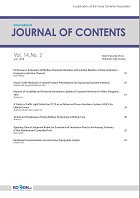- 권한신청
- P-ISSN1738-6764
- E-ISSN2093-7504
- KCI
 ISSN : 1738-6764
ISSN : 1738-6764
Subjective Symptom of Visual Display Terminal Syndrome and State Anxiety in Adolescent Smartphone Users
Jung-wha Choi (Eulji University Hospital)
Abstract
The objectives of this study were: 1) to determine smartphone addiction, visual display terminal syndrome (VDTS) related symptoms, and state anxiety among adolescents, and 2) to identify the relationship among these variables. Data were collected via selfadministrated questionnaire survey from May to June, 2013. The survey was carried out with 540 voluntary participants at 13 to 24 years old from middle schools, high schools, and universities in Korea. The presence and severity of smartphone addiction, VDTS symptoms, and state anxiety were measured using Korean Smartphone Addiction Proneness Scale, VDTS Questionnaire, and State Anxiety Inventory, respectively. Data were analyzed by Cohen’s Kappa coefficient, Kruskal-Wallis test, and Mann-Whitney U test. The mean score of smartphone addiction for all students was 2.17 ± 0.51. The mean scores of smartphone addiction depending on school grade were 2.12 ± 0.53, 2.03 ± 0.48, and 2.42 ± 0.43 for middle school, high school, and college students, respectively. Subjects who experienced minor level of VDTS symptoms had a score of 0.49 ± 0.49 for VDTS symptoms. The score was increased when the level of addiction was higher. There were significant differences in VDTS subjective symptoms among smartphone addiction groups (p<.001). High-risk group of smartphone addiction had the highest scores in every subdomain of VDTS symptoms. Differences were also found in state anxiety among the three groups with smartphone addiction. The findings of this study showed that approximately one out of three adolescents might be classified into problematic smartphone users. Therefore, it is important to educate problematic smartphone users about smartphone addiction and VDTS symptoms to prevent further addiction and aggravation of anxiety.
- keywords
- Smartphone, Addiction, VDT Syndrome, Anxiety, Adolescent
- 다운로드 수
- 조회수
- 0KCI 피인용수
- 0WOS 피인용수

